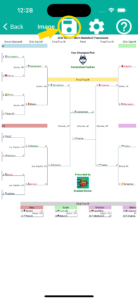The 2024 NCAA Men’s Basketball Championship Tournament continues an 85-year streak that there has been at least one team making their tournament debut. This year’s virgin team is the Stetson University Hatters from Deland, Florida, representing the Atlantic Sun conference.
Conference tournament upsets resulted in an unprecedented number of ‘Bubble-Buster’ teams. Analysts feel that six teams from multi-bid conferences earned an automatic berth when they otherwise would not have made the tournament. This means that those six conferences received an ‘extra’ invitation, stealing a bid from an otherwise higher rated team. Those bubble-busters caused the ‘Last Four In’ – the final at-large invitees – to move up to the number 10 seed line. This is the first time the First Four Round contains games between number 10 seeds.
Twenty-one (21) number 1 seeds lost in their conference tournament this postseason. This is the largest number of conference tournament upsets in at least ten years.
The North Carolina State Wolfpack (11-seed, 22-14) became the first double-digit seed (the ACC 10-seed) to win a conference tournament in more than a decade. NC State claimed their first Atlantic Coast Conference tourney title since 1987 when NCAA champion Jim Valvano was their head coach.
The Iowa State Cyclones’ (2-seed, 27-7) 28-point victory over the Houston Cougars (1-seed, 30-4) in the Big 12 conference championship final was the largest margin of victory over an Associated Press Number 1-ranked program in fifty-six seasons. The last game to exceed this margin of victory was UCLA’s win (101-69) over Houston in the 1968 Final Four.
The East Region headed by Connecticut has 11 automatic qualifiers (teams that won their conference tournament), the West has 8 AQs, the Midwest: 7, and the South Region: 6.
The Big 12 and SEC led all conferences with eight teams earning tournament berths. The Big Ten and Mountain West tied for the second-most with six teams receiving bids.
If you are looking for information to talk you off prohibitive favorite Connecticut, consider this: no defending champion has made it past the Sweet Sixteen since Florida in 2007. In the past six tournaments, the defending champ was eliminated in the first or second round (1-seed Kansas in 2023, 1-seed Baylor in 2022, 4-seed Virginia in 2021, 6-seed Villanova in 2019, 2-seed North Carolina in 2018, and 1-seed Villanova in 2017).
A team seeded 4 or worse has made the Final Four in each of the last thirteen seasons. In last year’s turbulent tournament, 4-seed Connecticut was the best seed to make the Final Four.
The Duquesne University Dukes (11-seed, 23-11) out of Pittsburgh, Pennsylvania enter the tournament for the first time in 47 years. This is the longest absence of any team in the field.
The Nebraska Cornhuskers (8-seed, 23-10) have joined the tournament field for the first time since 2014 and eighth time overall. They are the only school from a power conference to have never won a tournament game.


 When using this function from the Picks page, a bracket image will be generated showing your game selections with color-coding for correct and incorrect picks based on game results. The Years and Sim pages will show brackets displaying the score of official or simulated games, respectively. Remember to Tap the Help ‘question mark’ icon for guidance on any of Bracket Masters pages.
When using this function from the Picks page, a bracket image will be generated showing your game selections with color-coding for correct and incorrect picks based on game results. The Years and Sim pages will show brackets displaying the score of official or simulated games, respectively. Remember to Tap the Help ‘question mark’ icon for guidance on any of Bracket Masters pages. The save location will default to the general user location of your device, though you can select a specific location using the save dialog. The image will be assigned a generated file name, though this may be changed using the save dialog, or from the Image Settings page (by tapping the gear icon). Use your device’s Files app to access the image after saving it. Using an Apple device, the bracket image won’t be accessible by the picture Gallery app unless you actively Share it to the pictures folder or an album using the Files app Share functions. Also use the Share function to text message or email the image. With an Android device, the bracket image will typically be automatically accessible by other apps, but if it isn’t the process is similar to that of Apple devices — use an Android file management app to Share the image with other apps or move it to another folder.
The save location will default to the general user location of your device, though you can select a specific location using the save dialog. The image will be assigned a generated file name, though this may be changed using the save dialog, or from the Image Settings page (by tapping the gear icon). Use your device’s Files app to access the image after saving it. Using an Apple device, the bracket image won’t be accessible by the picture Gallery app unless you actively Share it to the pictures folder or an album using the Files app Share functions. Also use the Share function to text message or email the image. With an Android device, the bracket image will typically be automatically accessible by other apps, but if it isn’t the process is similar to that of Apple devices — use an Android file management app to Share the image with other apps or move it to another folder.